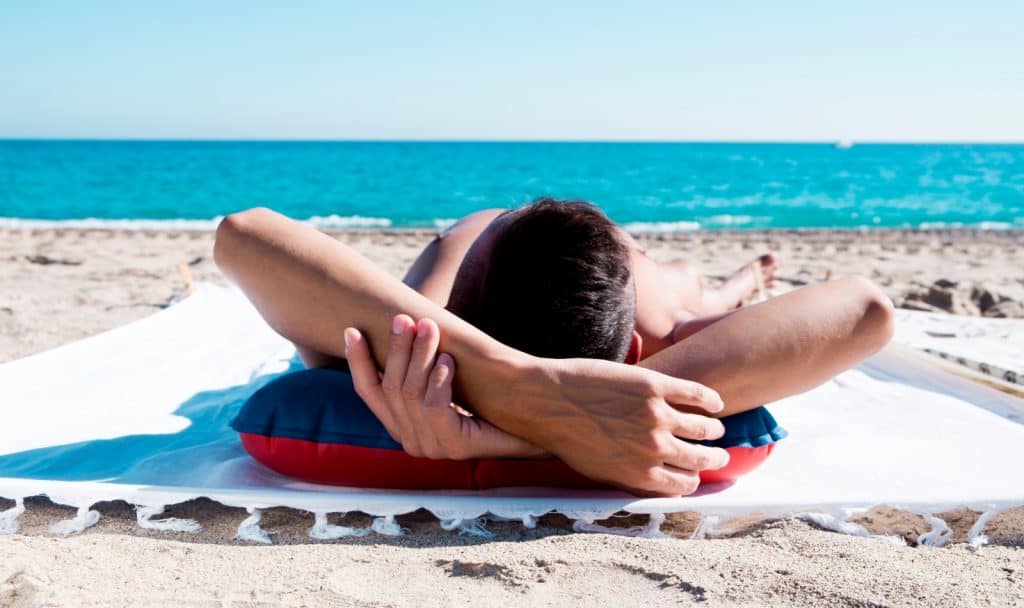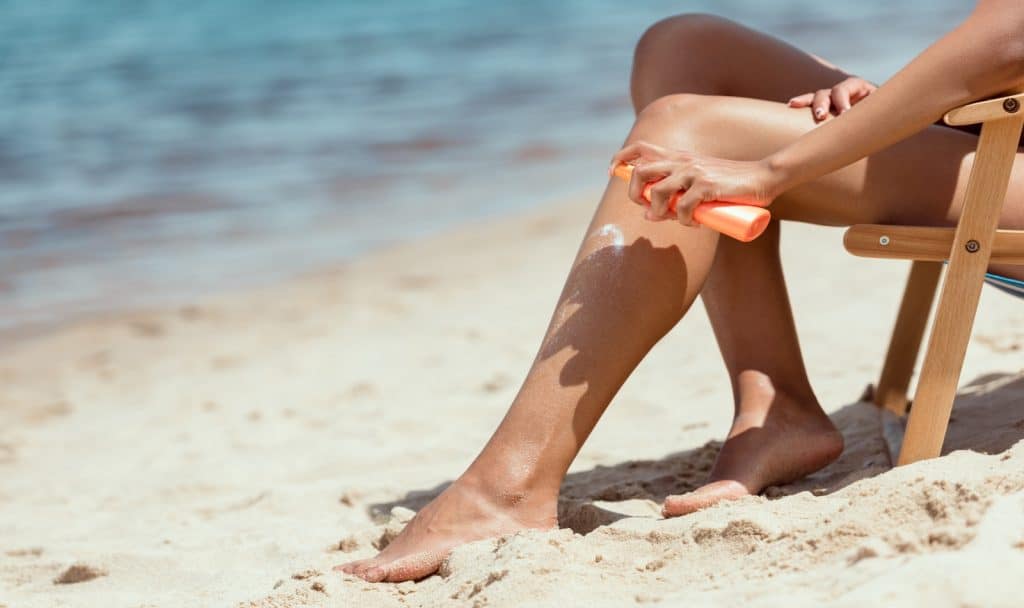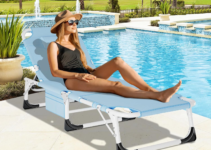Can you get tan when it’s cloudy?
Short answer, yes, you can; the real questions are how…and how well?
We’ll explore all the ins and outs of getting a tan even when you can barely see the sun peeking through the clouds.
Let’s dig in, shall we?
Don’t forget to also check our spray tanning machine reviews!
Table of Contents
Can You Get a Tan Through Clouds?
At the beginning of summer, tanning fanatics are psyched up and ready to lay out under those hot rays to start working on their bronze.
But not many people think about tanning during cloudy days; and it’s mostly because they don’t think it’s remotely possible.
Well, guess what? You don’t need to wait until you see him (the sun) to get a tan. You can tan through clouds when the UV rays find their way to your skin, enhancing melanin production.
To understand more about tanning with clouds, we’ll have to explain how UV rays impact your skin.
Before we do that, though, just a quick disclaimer: tanning even on a cloudy day can result in sunburns and other skin damage.
The only safe way to tan is by using self-tanning lotions and sprays, period. These tanning tips are merely for informational purpose only and we do not condone laying in the sun.
ALSO READ: How Long Does it Take to Tan in the Sun?
Science Behind Tanning
When you expose your skin to ultraviolet rays, it causes the skin cells to produce the pigment melanin that darkens through oxidation.
With enough time in the sun, the cells migrate closer to the skin’s top surface, producing more melanin and further darkening it.
The pigment absorbs UV radiation and defends further penetration to the skin tissue.
How Does Tanning Work?
The bronze tan you get is the reaction your skin gives when it can’t stand the effects of exposure to sun rays any more. It’s kind of like your skin’s defense system against the sun’s harmful rays.
But the main takeaway here is that it’s not overexposure to the visible sunlight that causes sunburns, tan, or cancer.
When sunbathing, your skin tans as a result of overexposure to UVB or UVA rays. The intensity of the sun’s rays changes depending on the type of clouds and altitude.
For example, the grey clouds can stop at least 53% of UV rays from passing through when the beautiful fluffy white clouds only prevent 10% of UV rays from penetrating.
I guess that explains how you ended up with that unplanned tan or sunburn you got on a cloudy day.
Specialists have created the same rays through tanning beds which gives results faster than the natural sun.
READ MORE: How to Get a Tan in the Winter?
5 Tips for Tanning on a Cloudy Day
One mistake you can’t afford to make when tanning on a cloudy day is underestimating UV rays’ strength.
To achieve an even tan during cloudy weather, here are some tips.
#1 Tan at the Right Time

One great way to avoid the harshest effects of UV rays is choosing the best time to tan. Aim for times when the sun’s rays are at their weakest, or before 10 am and after 4 pm.
Hours between 10 am and 4 pm are considered the suns “peak hours,” and some people purposely tan during these hours to tan fast.
However, I don’t recommend it. Tanning when the sun rays are mild reduces your chances of getting burnt or developing patches, especially if you have a pale complexion.
Note the word “reduces.” It’s still entirely possible to burn at 8 am or 5 pm!
In this video, we’ll dive into the world of UV lamps to help you achieve the perfect, safe tan at home:
#2 Choose the Right Location

Even when it’s cloudy, you can easily spot parts that are less so than others. Spots where you can almost see the sun peeking through.
If your sole goal is to achieve an even tan, then those are the spots you’ll want to pick.
That said, ensure you moderate your tanning time to avoid getting sunburns. Don’t fall into the trap of thinking that just because it’s cloudy, you have to stay outside longer.
#3 Follow the Normal Pre-Tanning Routine

Even during cloudy days, it’s important to prepare your skin well before a tan. We’ve shared tips on doing just that in our “can you tan without lotion” discussion. Check the summary video below:
The pointers below summarize it.
- Exfoliate your skin for a good and long-lasting tan. The night before your tanning session, take a shower using an excellent natural scrub to get rid of dead cells.
- Moisturize your skin to lock in the moisture after the shower and boost your skin’s health.
- Apply sunscreen. Go with sunscreen with SPF 10 or 15 to protect the overexposed areas.
#4 Tan on a Comfortable Towel or Chair

What does the chair you sit on having to do with a tan in cloudy weather? Everything.
This is because you need to stretch out your body well to ensure you tan everywhere and avoid patches.
Also, remember to keep turning to make sure you tan both sides of your body. You can use a timer and turn every 10 minutes.
If you have pale skin, avoid long hours in the sun and allow your skin to tan gradually and prevent the risk of getting sunburns
Also, it’s best to ensure that you stick to the same number of hours for all tanning sessions.
#5 Follow the Post-Tan Skincare Routine

Don’t be lax about your after-tan skincare routine. Here are some of the things you can do to keep the shine.
- Take a shower after tanning. This keeps your pores from clogging by getting rid of sweats and creams.
- Use good quality moisturizers to hydrate your skin.
- Take 12 ounces of water. This shouldn’t be a regular thing; it’s just crucial after staying overexposed to the sun for long hours.
Do You Need Lotion for Tanning on a Cloudy Day?
It’s important to use tanning lotion on a cloudy day. Based on cloud thickness, UV rays on a cloudy day can be stronger than on a sunny day.
This means it can cause more damage to your skin. Ensure you use tanning lotion and sunscreen even when tanning on a cloudy day.
Can You Get Tan When It’s Cloudy (Conclusion)
You can achieve a beautiful tan even on a cloudy day because the UV rays are still present.
Therefore, avoid overexposing your skin to the sun on a cloudy day or tanning for too long.
If you want to achieve a beautiful tan on a cloudy day without hurting your skin, the tips I discussed can help you do that.
Did you know it’s possible to get a sunburn or tan on a cloudy day?



